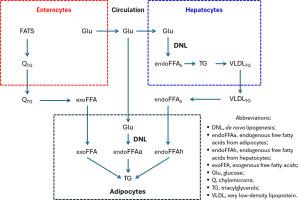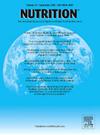重新审视新脂肪生成的概念,了解碳水化合物转化为脂肪的过程:不要再高估和推断 "脂肪在碳水化合物的火焰中燃烧 "这句名言。
IF 3.2
3区 医学
Q2 NUTRITION & DIETETICS
引用次数: 0
摘要
碳水化合物可通过新生脂肪生成(DNL)转化为脂肪酸。尽管DNL被认为是低效的,但这些内源性脂肪酸与进食脂肪酸一起对脂肪组织中的酯化途径做出了重大贡献。本文重温了 DNL 的概念,旨在讨论碳水化合物过量摄入和脂肪堆积的临床严重程度。虽然由于分子结构和新陈代谢(如氧化和热效应)的原因,脂肪摄入导致的脂肪储存比碳水化合物更有利于脂肪量的积累,但在碳水化合物长期过量摄入的情况下,碳水化合物也会大量参与脂肪生成和酯化。仅就单糖过量摄入而言,葡萄糖和果糖分别有利于皮下和内脏脂肪组织。虽然果糖和蔗糖被认为是非酒精性脂肪肝的罪魁祸首,但碳水化合物的能量过剩,无论其来源如何,都可以被认为是肥胖的根本原因。有趣的是,脂肪细胞中一定程度的 DNL 可能有利于减轻肝脏中脂肪酸的大量沉积,从而发挥生理作用。虽然 "脂肪在碳水化合物的火焰中燃烧 "是一个值得称赞的短语,几十年来一直有助于描述生物化学的基本概念,但时至今日,它似乎被高估和推断了。DNL 不可忽视。现在是时候将 DNL 视为健康和疾病中的一个有效生化过程了。本文章由计算机程序翻译,如有差异,请以英文原文为准。

Revisiting the concepts of de novo lipogenesis to understand the conversion of carbohydrates into fats: Stop overvaluing and extrapolating the renowned phrase “fat burns in the flame of carbohydrate”
Carbohydrates can be converted into fatty acids via de novo lipogenesis (DNL). Although DNL is considered inefficient, these endogenous fatty acids contribute substantially to the esterification pathway in adipose tissue, together with fatty acids of feeding. This article revisited the concepts of DNL and aimed to discuss the clinical magnitude of carbohydrate overfeeding and fat mass accumulation. Although fat storage resulting from fat intake is more favorable for fat mass accrual than carbohydrates due to molecule structure and metabolism (e.g., oxidation and thermic effect), carbohydrates can substantially participate in lipogenesis and esterification under excess carbohydrate intake over time. Regarding only monosaccharide overfeeding, glucose and fructose favor the subcutaneous and visceral adipose tissue, respectively. While fructose and sucrose are considered villains in nonalcoholic fatty liver disease, energy surplus from carbohydrates, regardless of sources, can be considered an underlying cause of obesity. Interestingly, some degree of DNL in adipocytes may be favorable to mitigate a high deposition of fatty acids in the liver, conferring a physiological role. Although "fat burns in the flame of carbohydrate" is a praiseworthy phrase that has helped describe basic concepts in biochemistry for many decades, it appears to be overvalued and extrapolated even nowadays. DNL cannot be neglected. It is time to consider DNL an efficient biochemical process in health and disease.
求助全文
通过发布文献求助,成功后即可免费获取论文全文。
去求助
来源期刊

Nutrition
医学-营养学
CiteScore
7.80
自引率
2.30%
发文量
300
审稿时长
60 days
期刊介绍:
Nutrition has an open access mirror journal Nutrition: X, sharing the same aims and scope, editorial team, submission system and rigorous peer review.
Founded by Michael M. Meguid in the early 1980''s, Nutrition presents advances in nutrition research and science, informs its readers on new and advancing technologies and data in clinical nutrition practice, encourages the application of outcomes research and meta-analyses to problems in patient-related nutrition; and seeks to help clarify and set the research, policy and practice agenda for nutrition science to enhance human well-being in the years ahead.
 求助内容:
求助内容: 应助结果提醒方式:
应助结果提醒方式:


